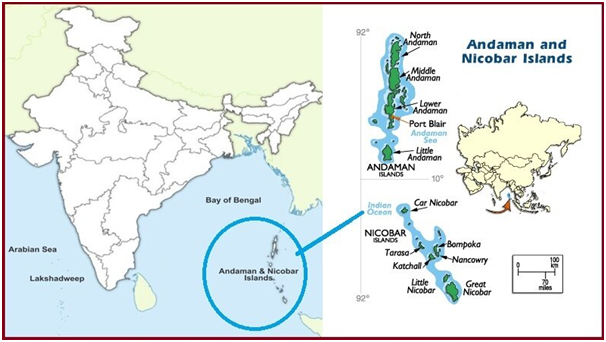Biodiversity & Environment
NITI Aayog’s Project for Great Nicobar Island
- 10 May 2021
- 5 min read
Why in News
Recently, the Environment Appraisal Committee which flagged concerns over the project has now ‘recommended’ it ‘for grant of terms of reference’ for Environmental Impact Assessment (EIA) studies.
- In August, 2020 the Prime Minister had declared that the Andaman and Nicobar islands will be developed as a "maritime and startup hub".
Key Points
- About the Project:
- The proposal includes an international container trans-shipment terminal, a greenfield international airport, a power plant and a township complex spread over 166 sq. km. (mainly pristine coastal systems and tropical forests).
- It is estimated to cost Rs. 75,000 crore.
- Issues with Project:
- Lack of details on seismic and tsunami hazards, freshwater requirement details, and details of the impact on the Giant Leatherback turtle.
- No details of the trees to be felled—a number that could run into millions since 130 sq. km. of the project area has some of the finest tropical forests in India.
- A number of additional issues include about Galathea Bay, the site of the port and the centrepiece of the NITI Aayog proposal.
- Galathea Bay is an iconic nesting site in India of the enigmatic Giant Leatherback, the world’s largest marine turtle—borne out by surveys done over three decades.
- Ecological surveys in the last few years have reported a number of new species, many restricted to just the Galathea region.
- These include the critically endangered Nicobar shrew, the Great Nicobar crake, the Nicobar frog, the Nicobar cat snake, a new skink (Lipinia sp), a new lizard (Dibamus sp,) and a snake of the Lycodon sp that is yet to be described.
- The site selection for the port had been done mainly on technical and financial criteria, ignoring the environmental aspects.
- Action Points listed out by the Committee:
- There is a need for an independent assessment of terrestrial and marine biodiversity, a study on the impact of dredging, reclamation and port operations, including oil spills.
- The need for studies of alternative sites for the port with a focus on environmental and ecological impact, especially on turtles, analysis of risk-handling capabilities.
- A seismic and tsunami hazard map, a disaster management plan, details of labour, labour camps and their requirements, an assessment of the cumulative impact, and a hydro-geological study to assess impact on round and surface water regimes.
Great Nicobar
- About:
- Great Nicobar is the southernmost island of the Nicobar Islands Archipelago.
- It covers 1,03,870 hectares of unique and threatened tropical evergreen forest ecosystems.
- It is home to a very rich ecosystem, including 650 species of angiosperms, ferns, gymnosperms, bryophytes, among others.
- In terms of fauna, there are over 1800 species, some of which are endemic to this area.
- Ecological Characteristics:
- The Great Nicobar Biosphere Reserve harbours a wide spectrum of ecosystems comprising tropical wet evergreen forests, mountain ranges reaching a height of 642 m (Mt. Thullier) above sea level, and coastal plains.
- Tribe:
- The Mongoloid Shompen Tribe, about 200 in number, live in the forests of the biosphere reserve particularly along the rivers and streams.
- They are hunters and food gatherers, dependent on forest and marine resources for sustenance.
- Another Mongoloid Tribe, Nicobarese, about 300 in number, used to live in settlements along the west coast.
- After the tsunami in 2004, which devastated their settlement on the western coast, they were relocated to Afra Bay in the North Coast and Campbell Bay.
- The Mongoloid Shompen Tribe, about 200 in number, live in the forests of the biosphere reserve particularly along the rivers and streams.







